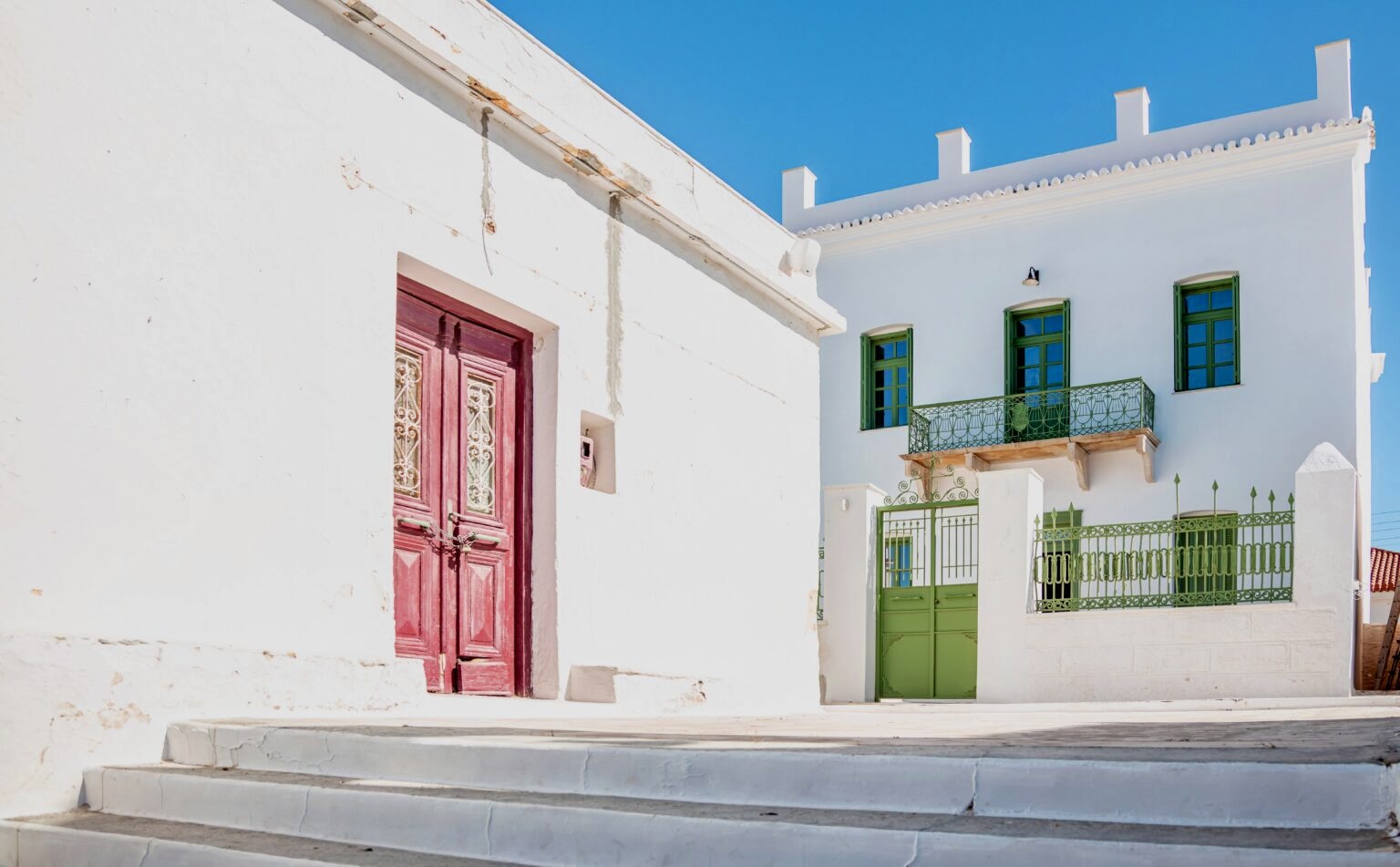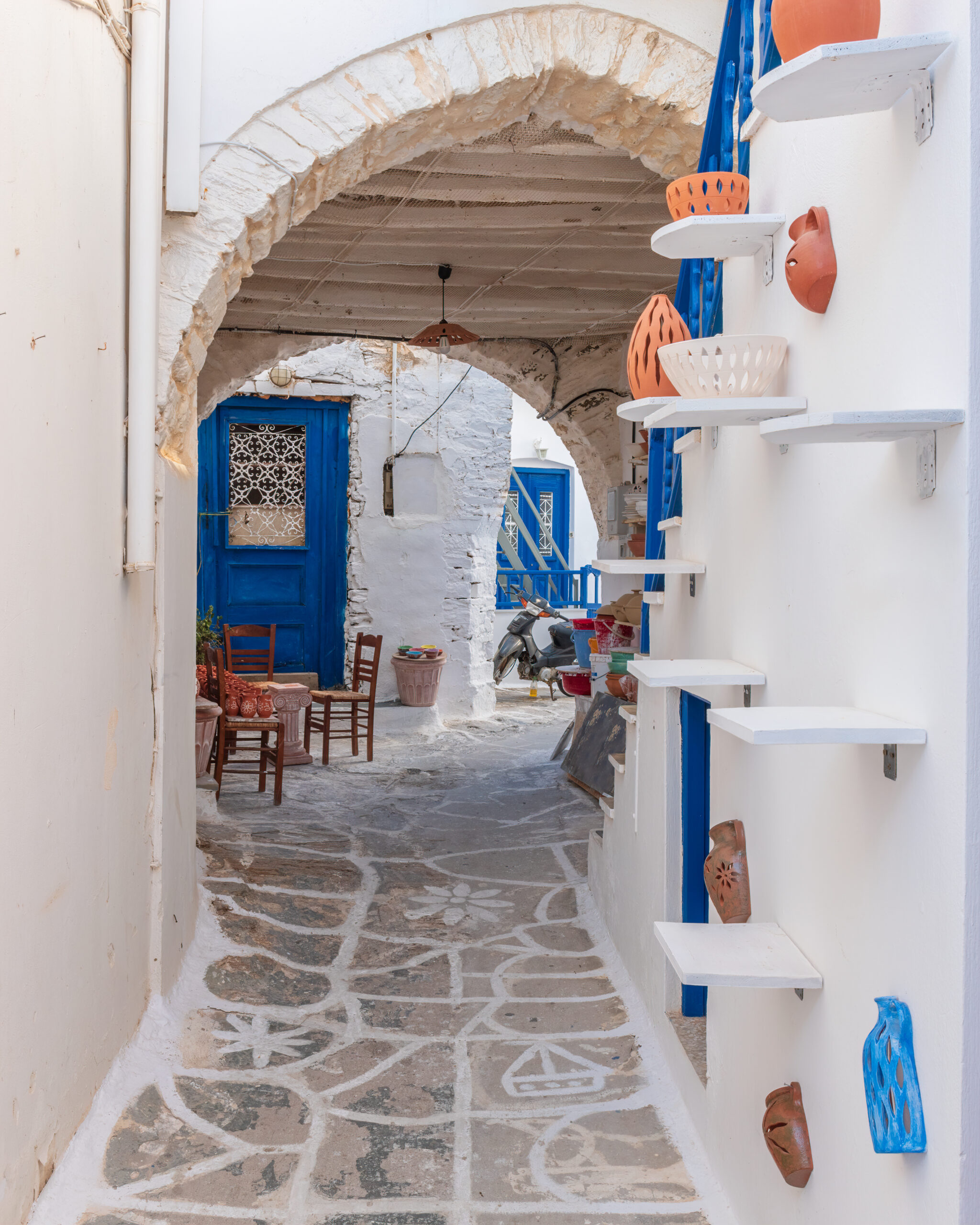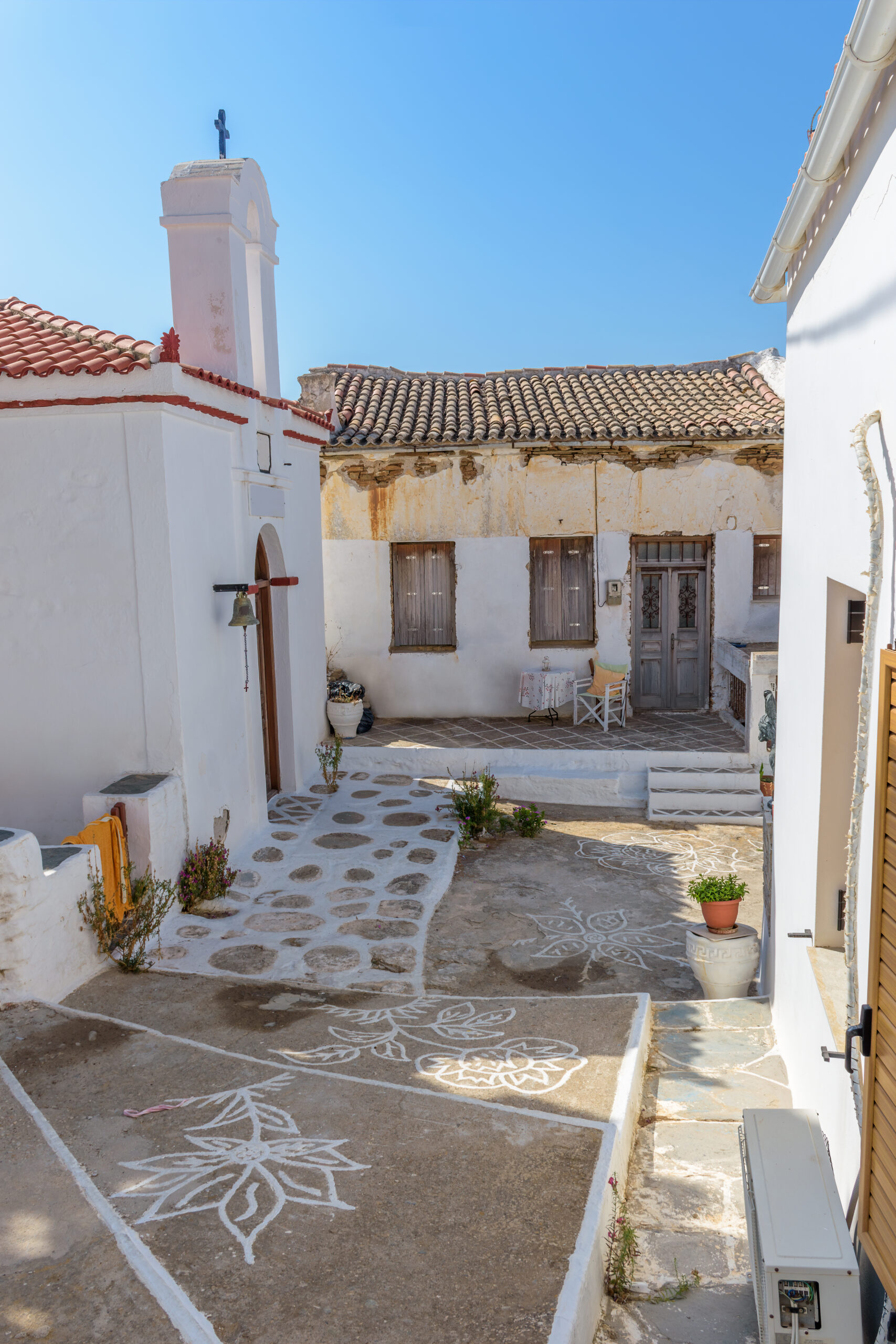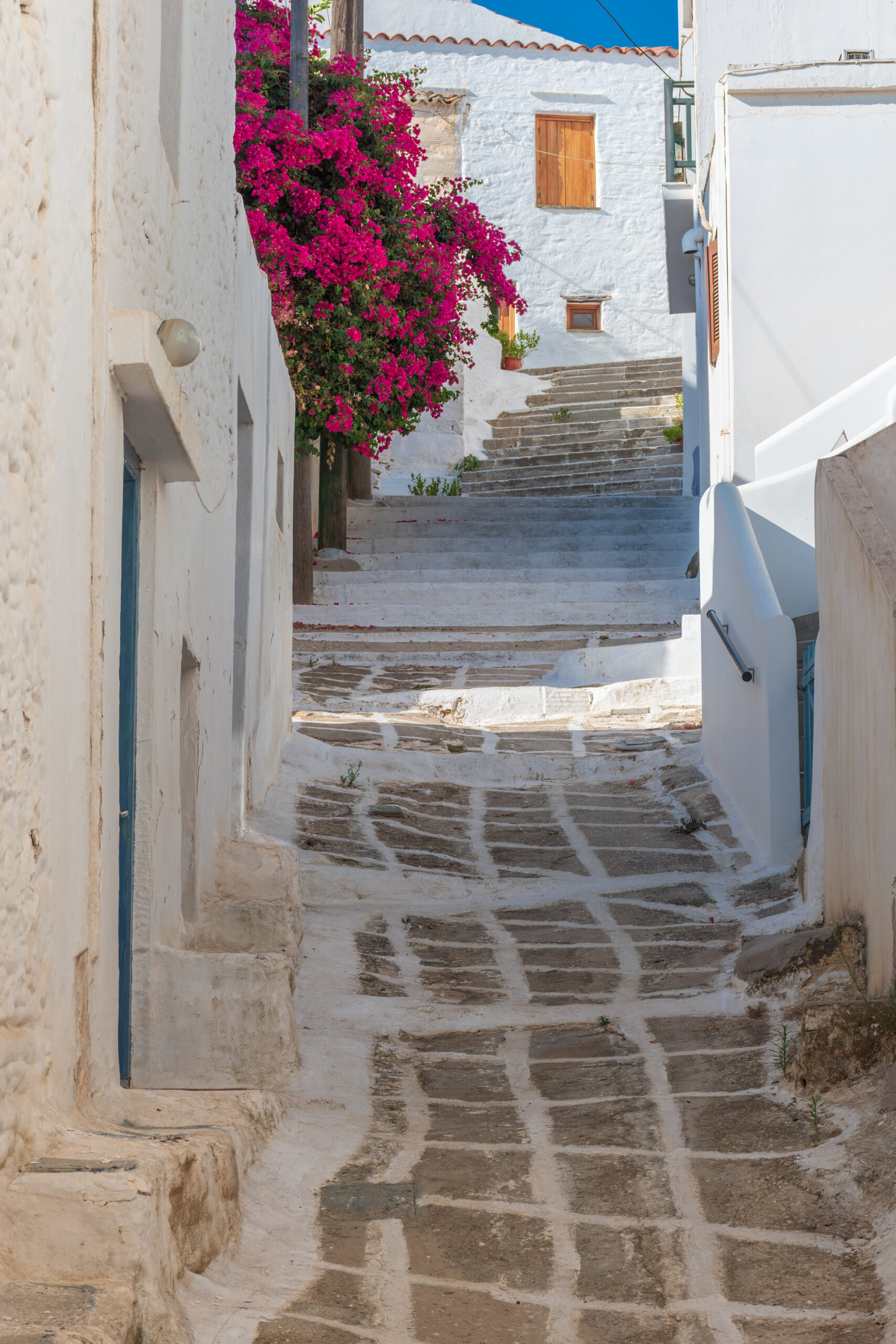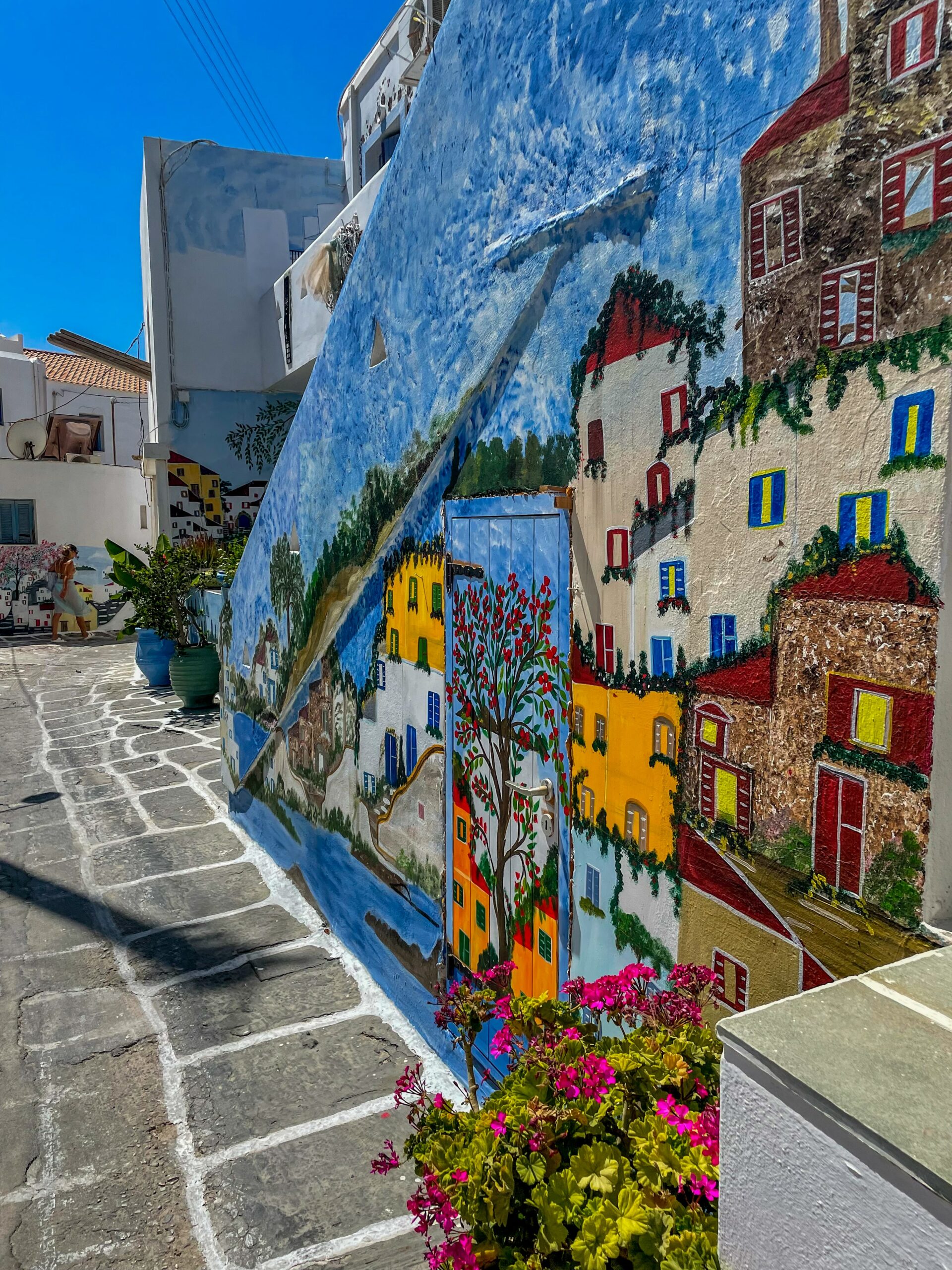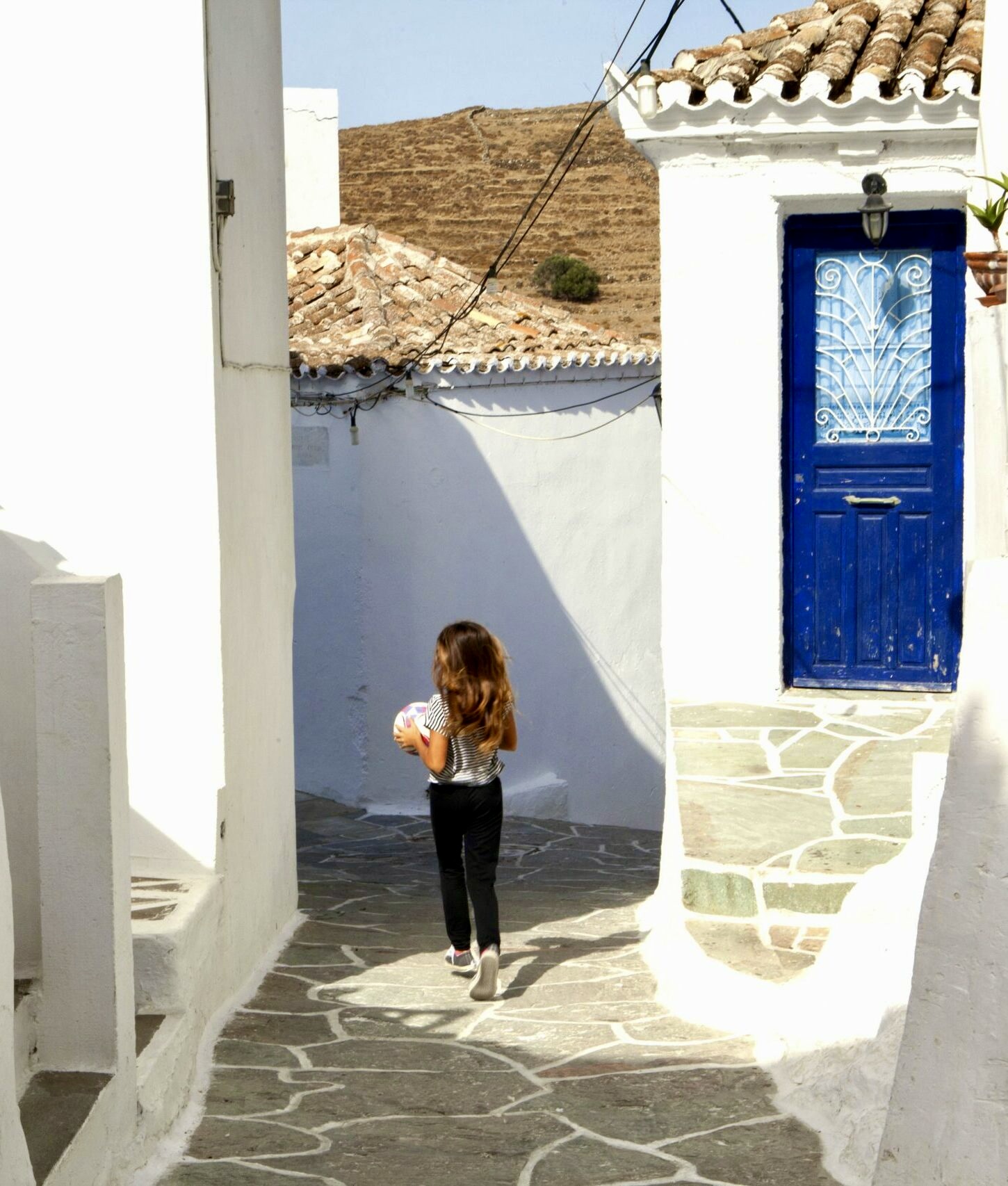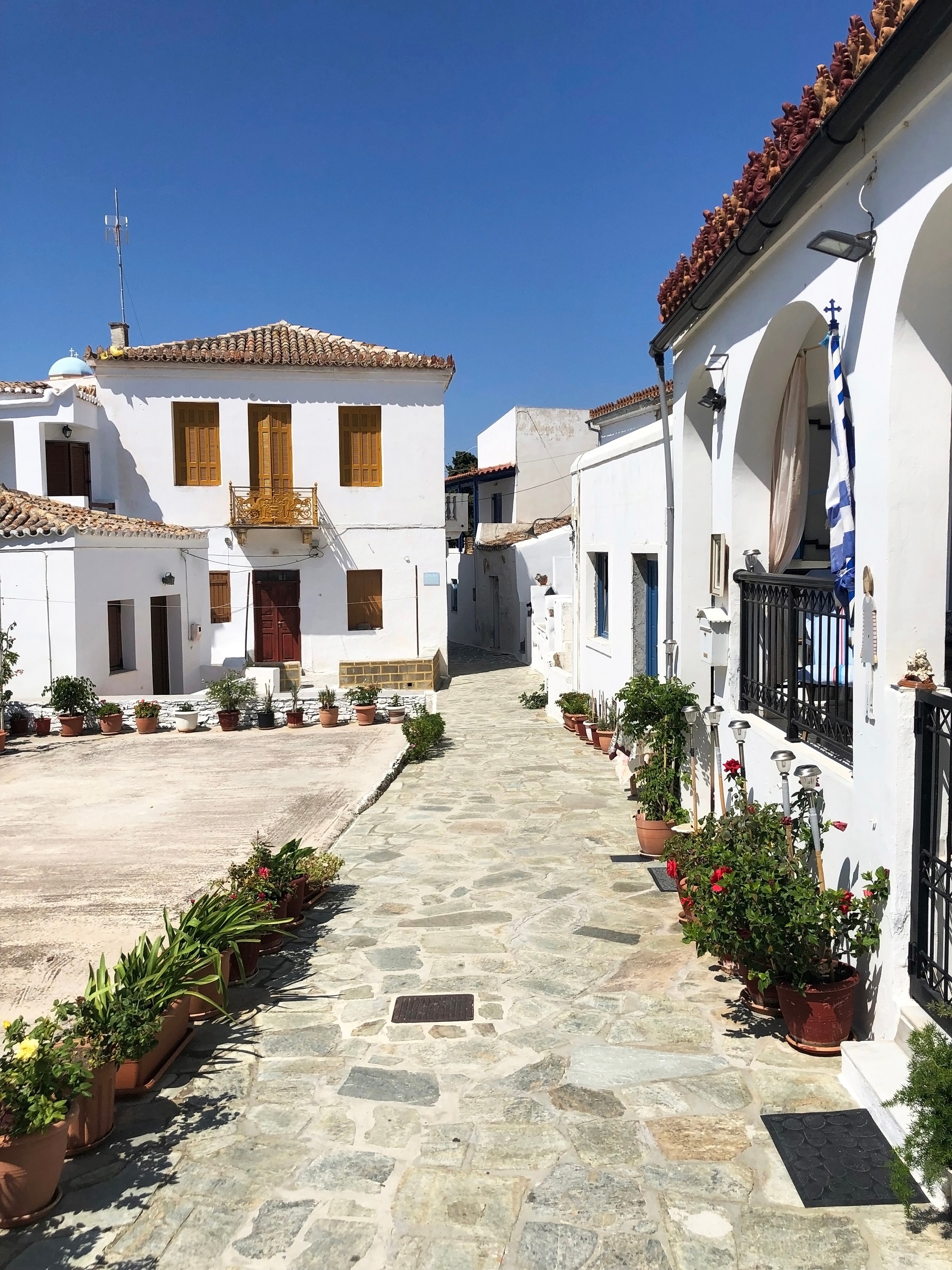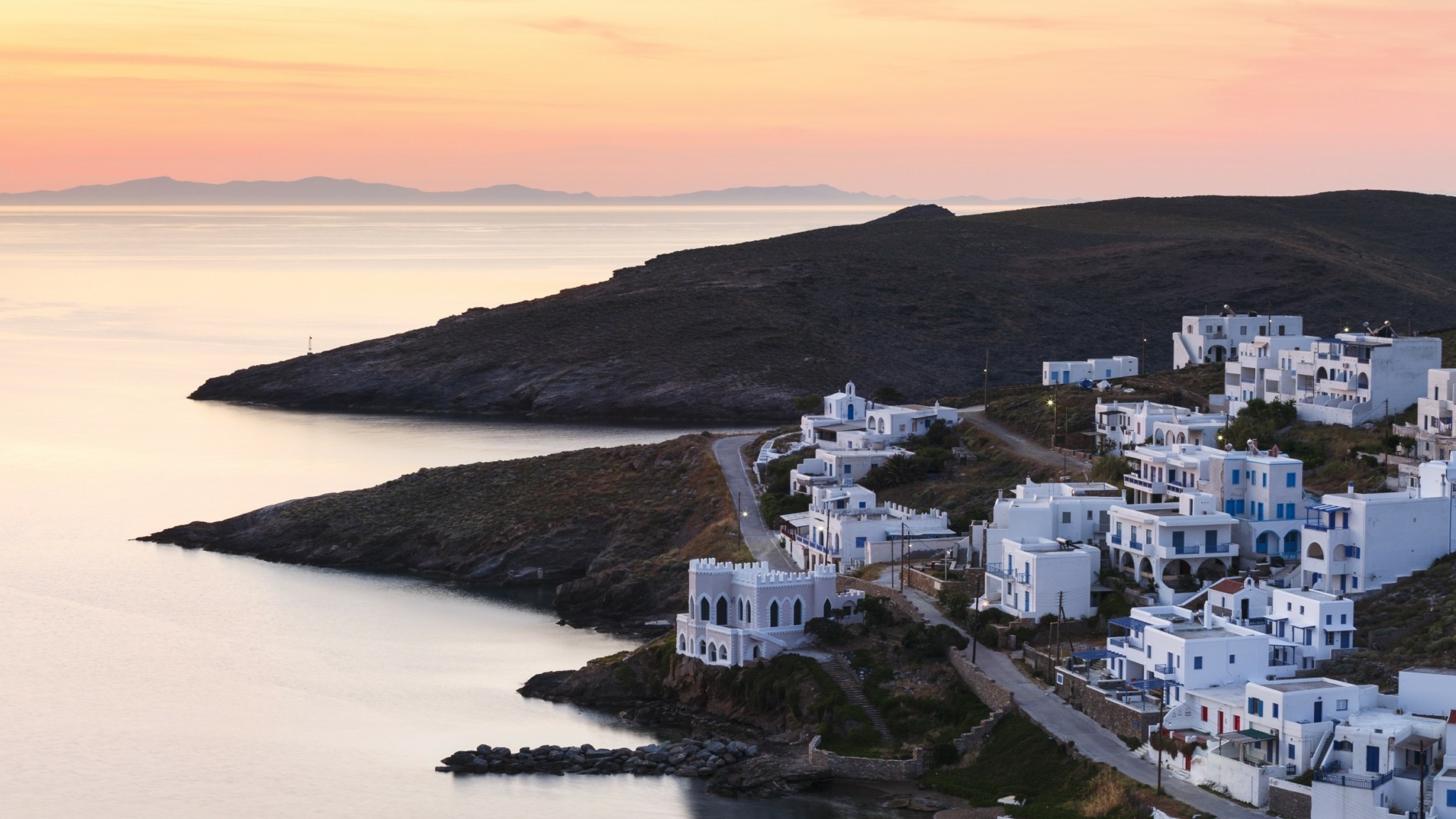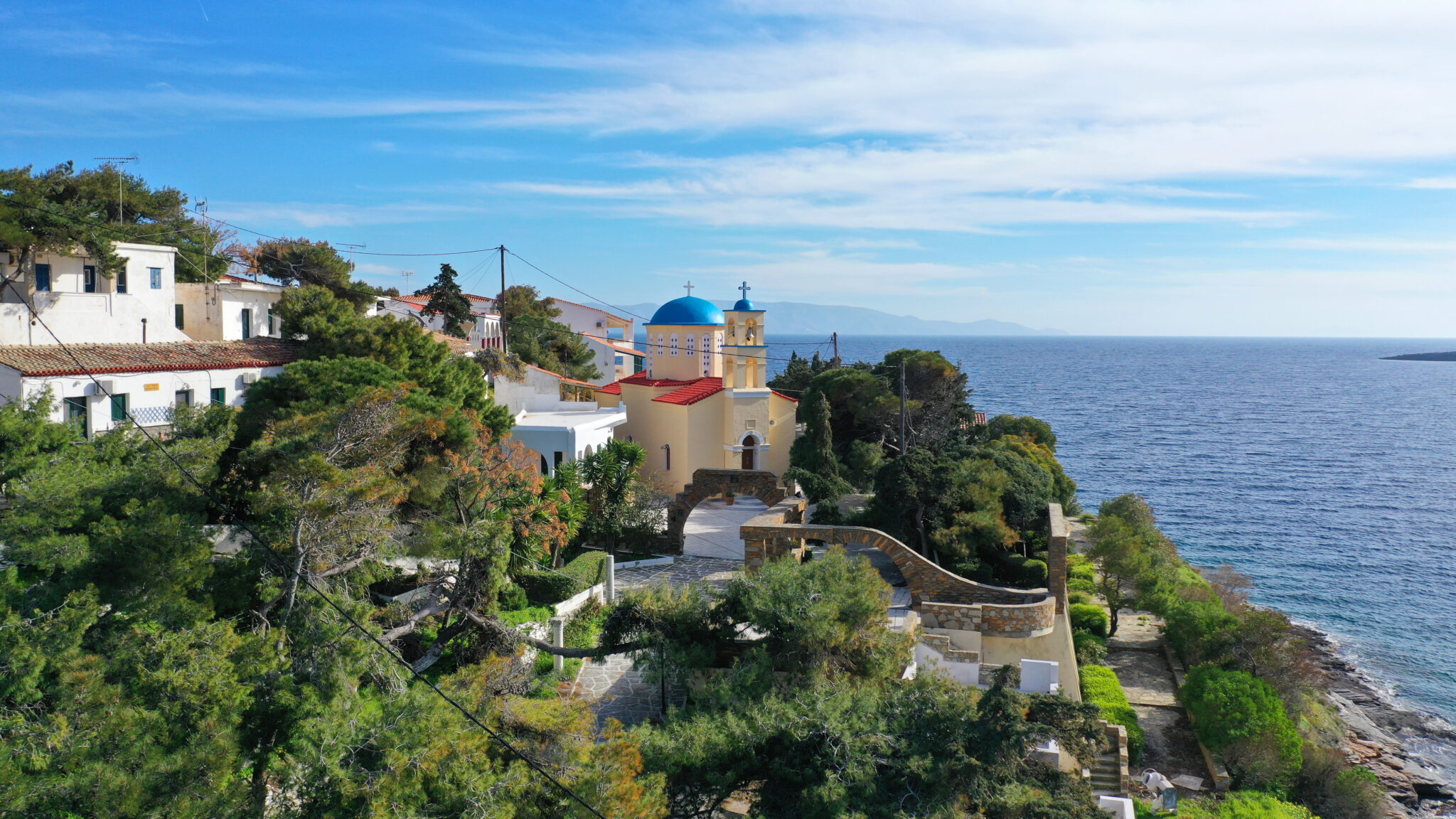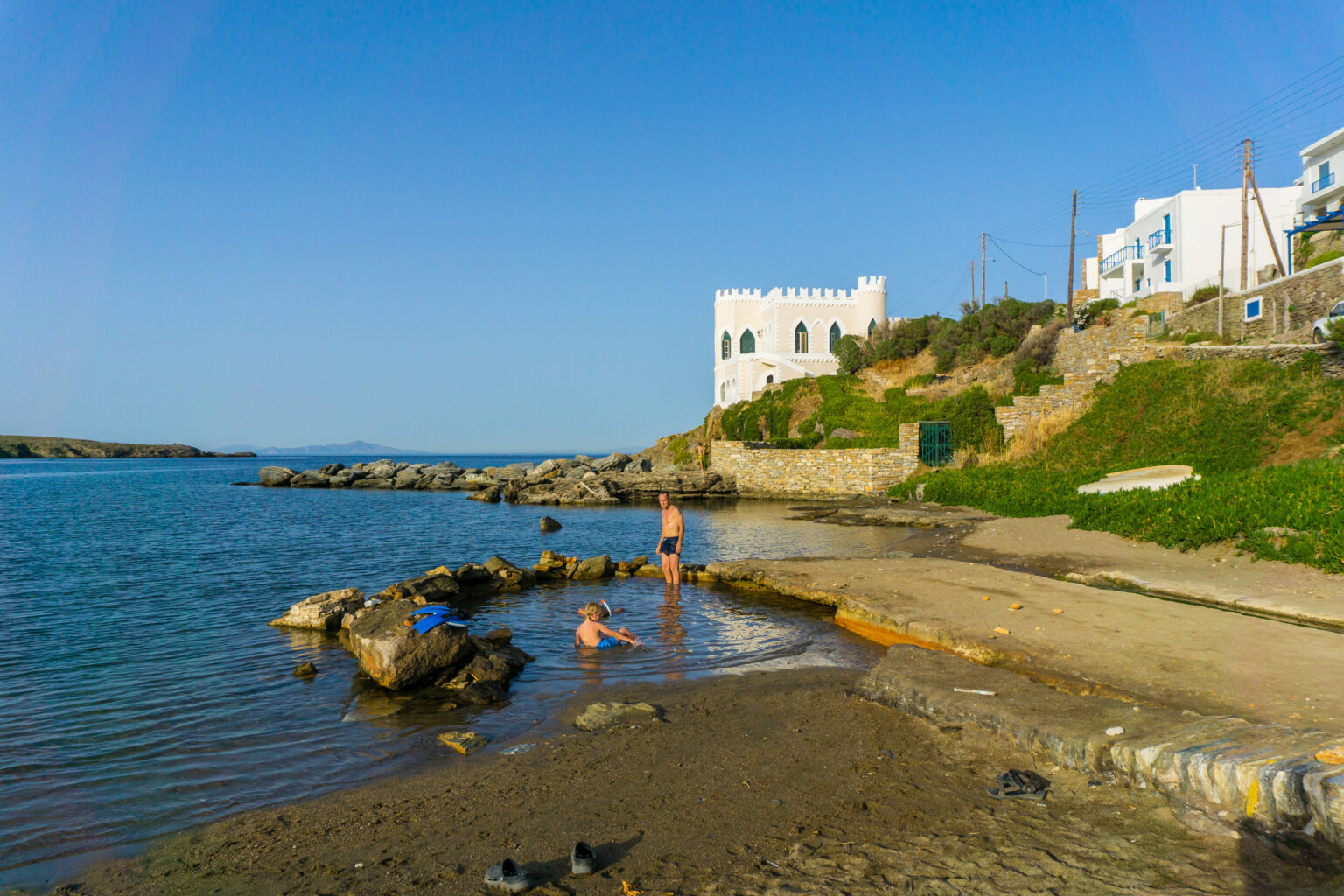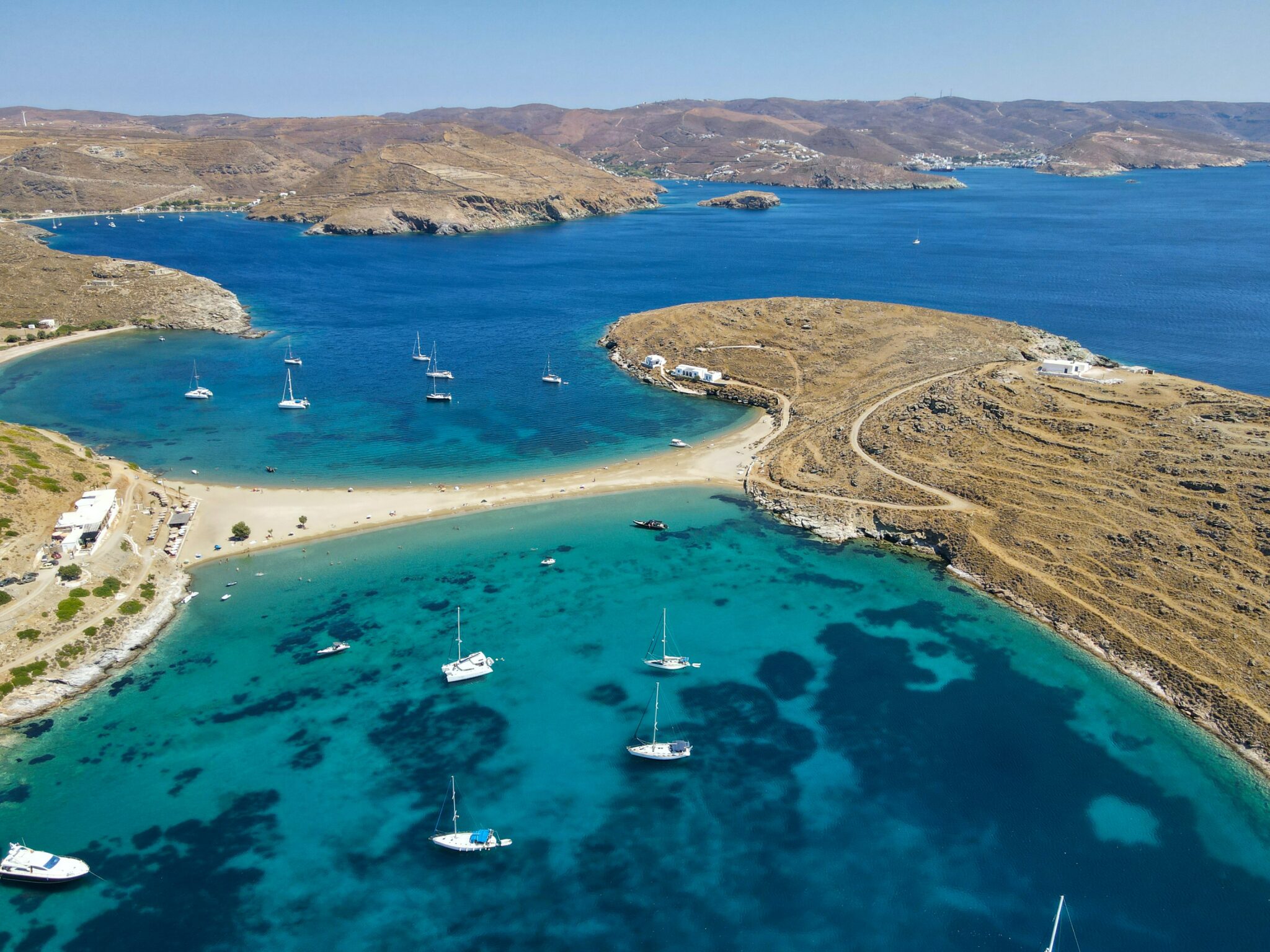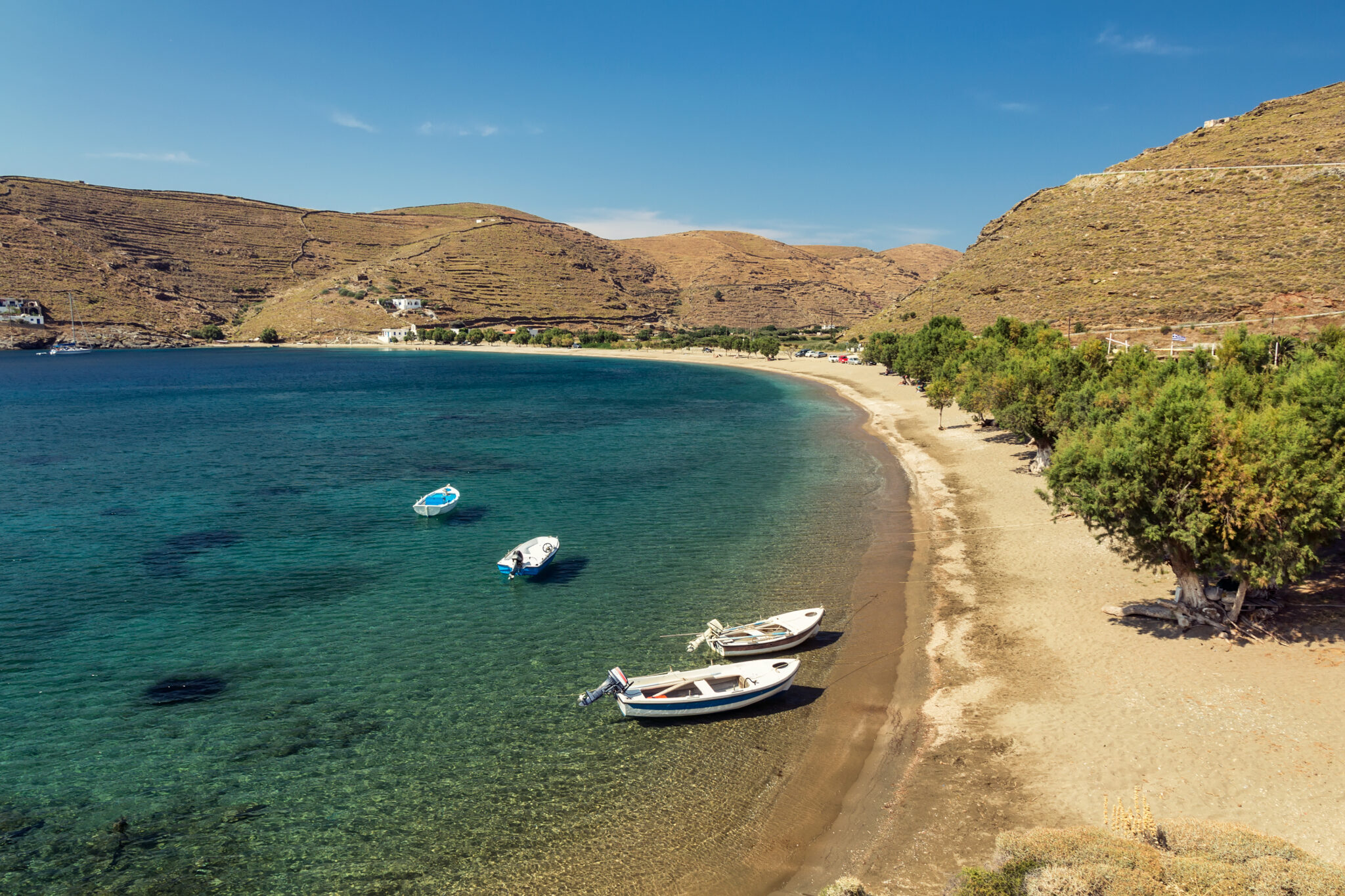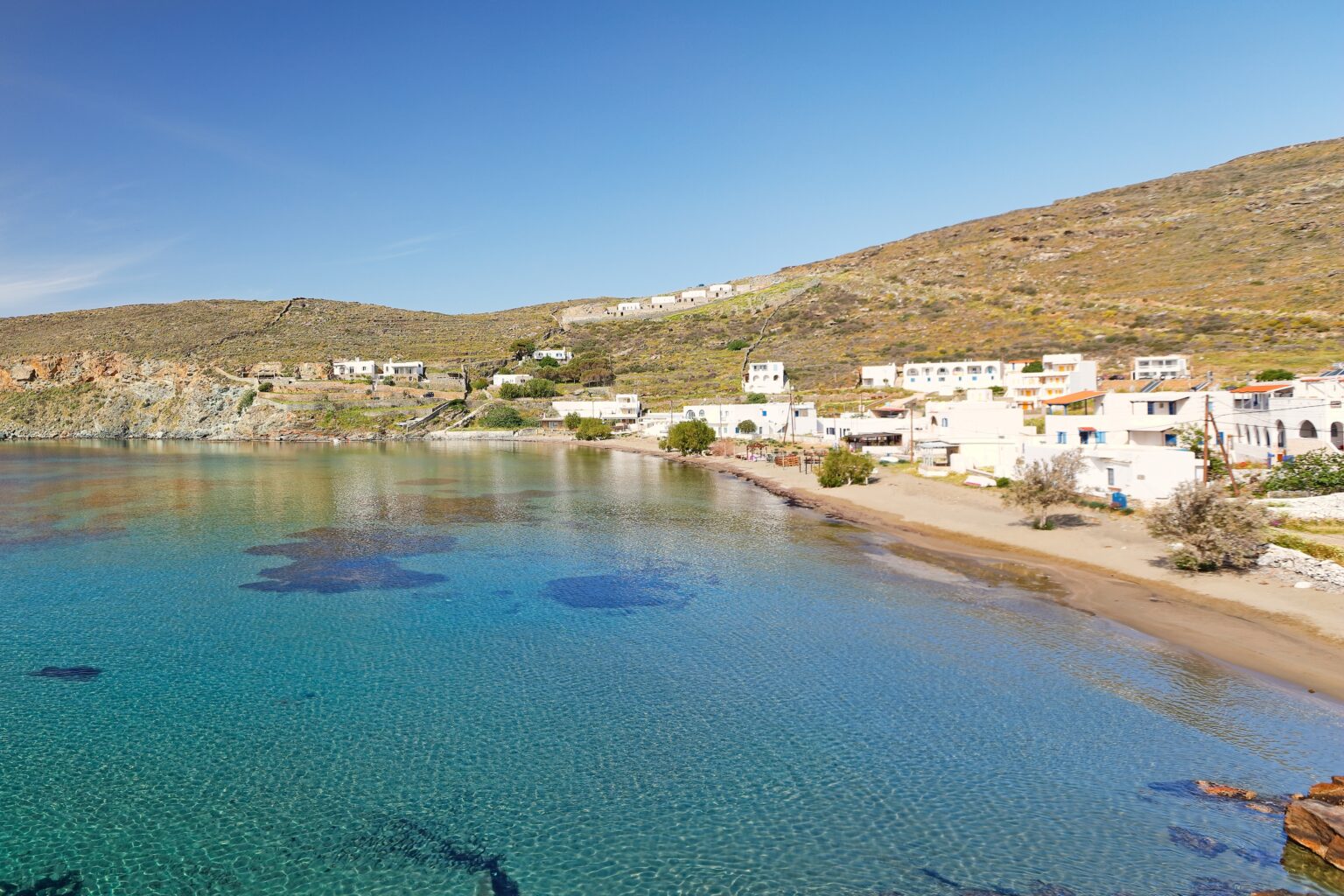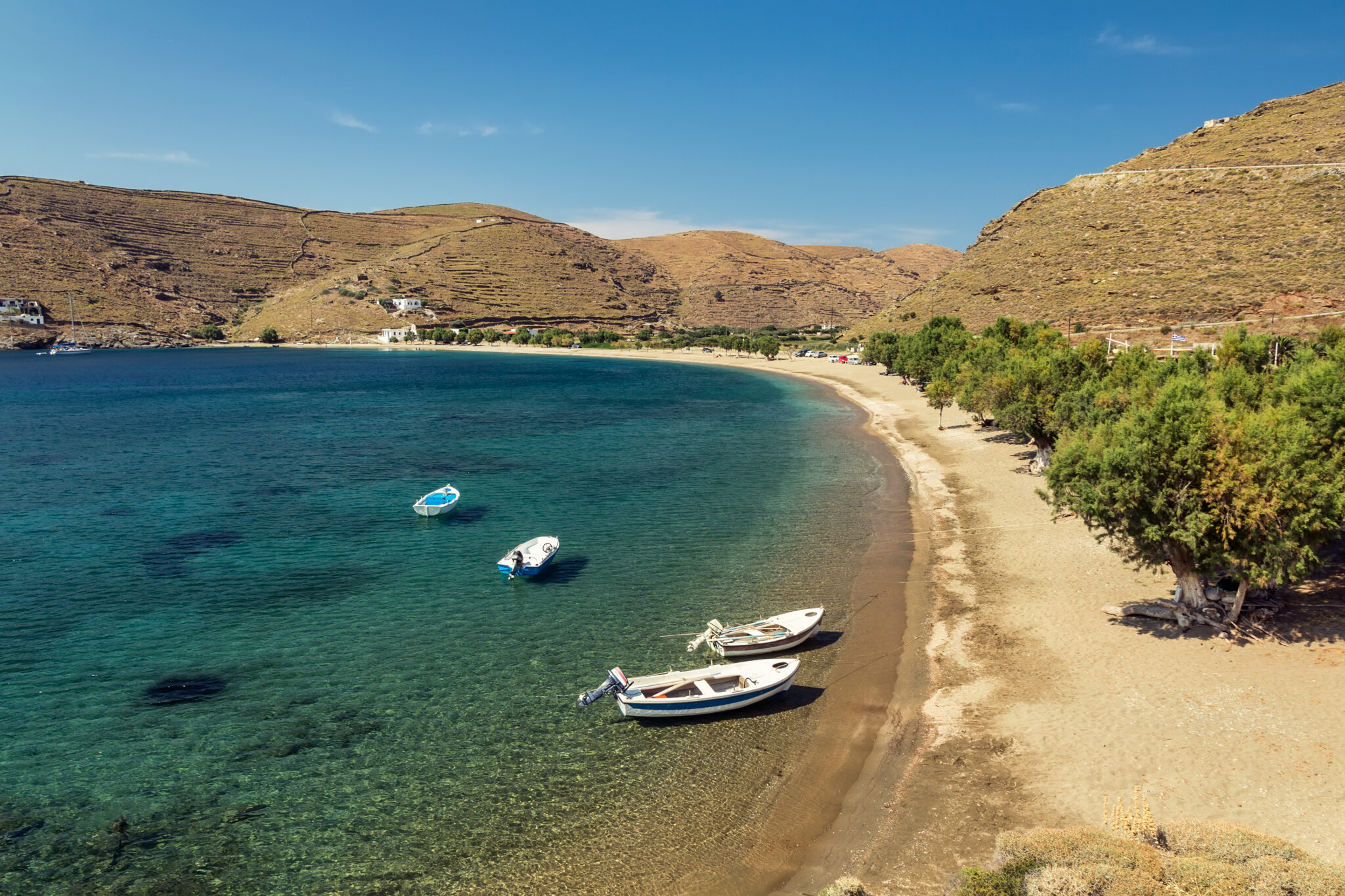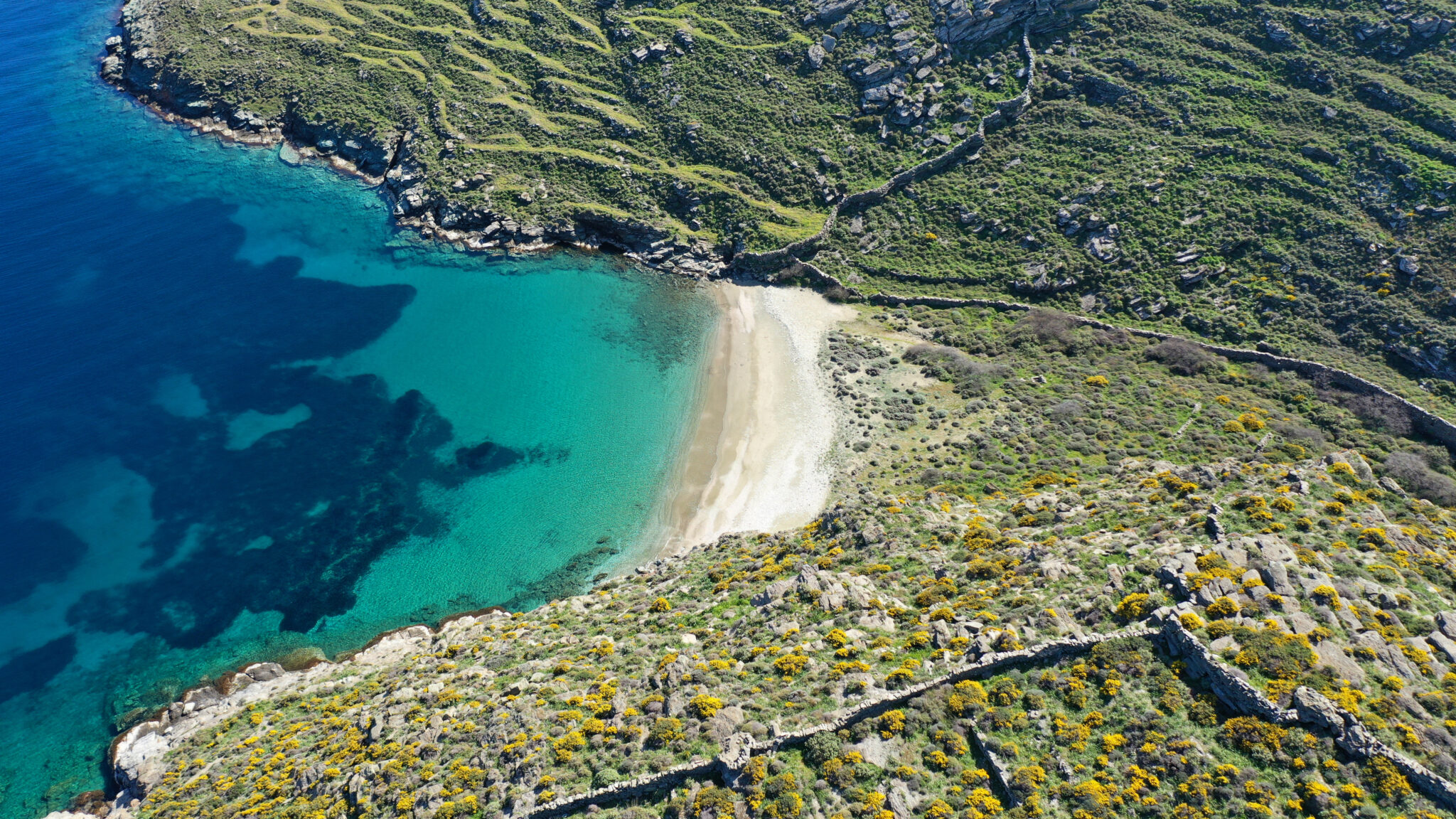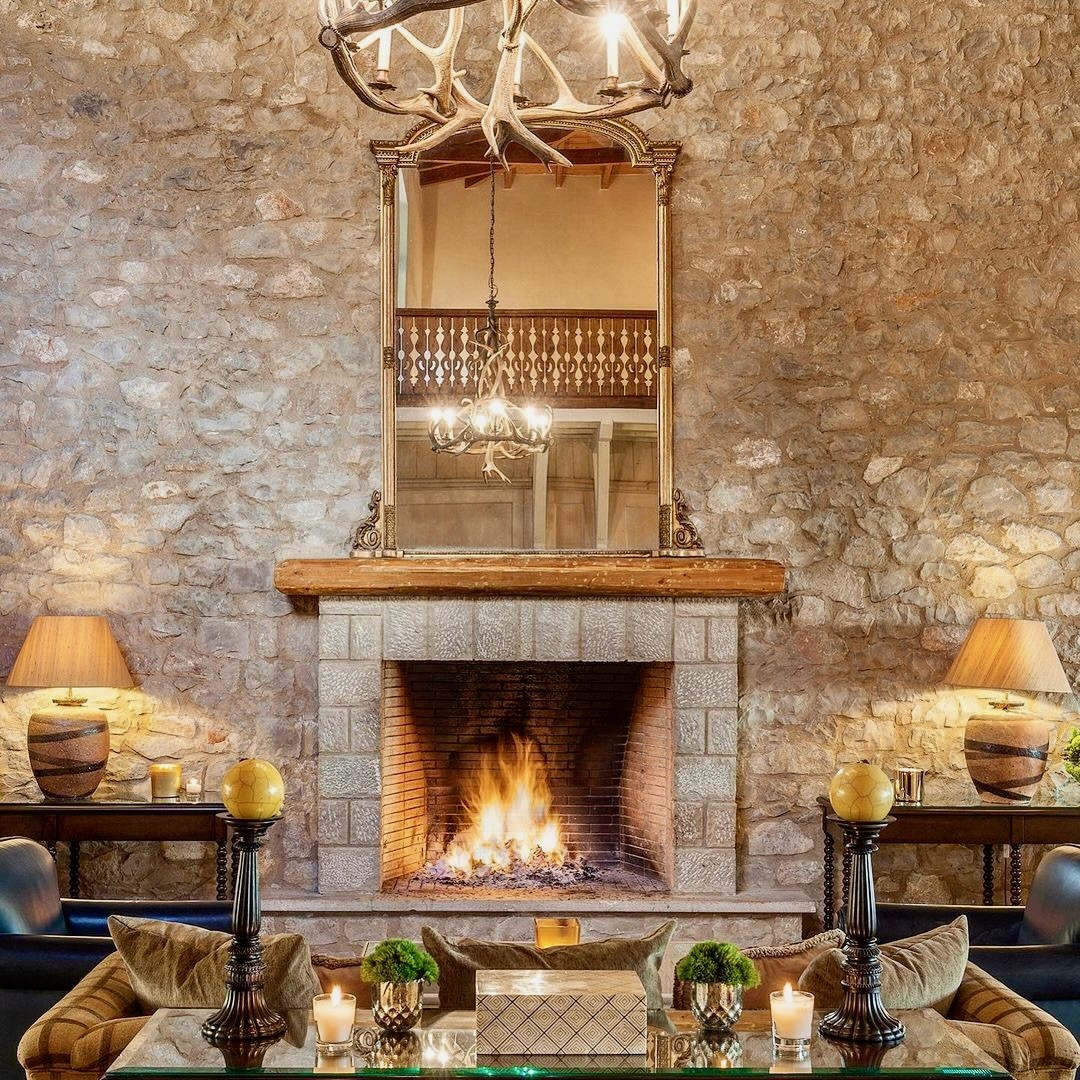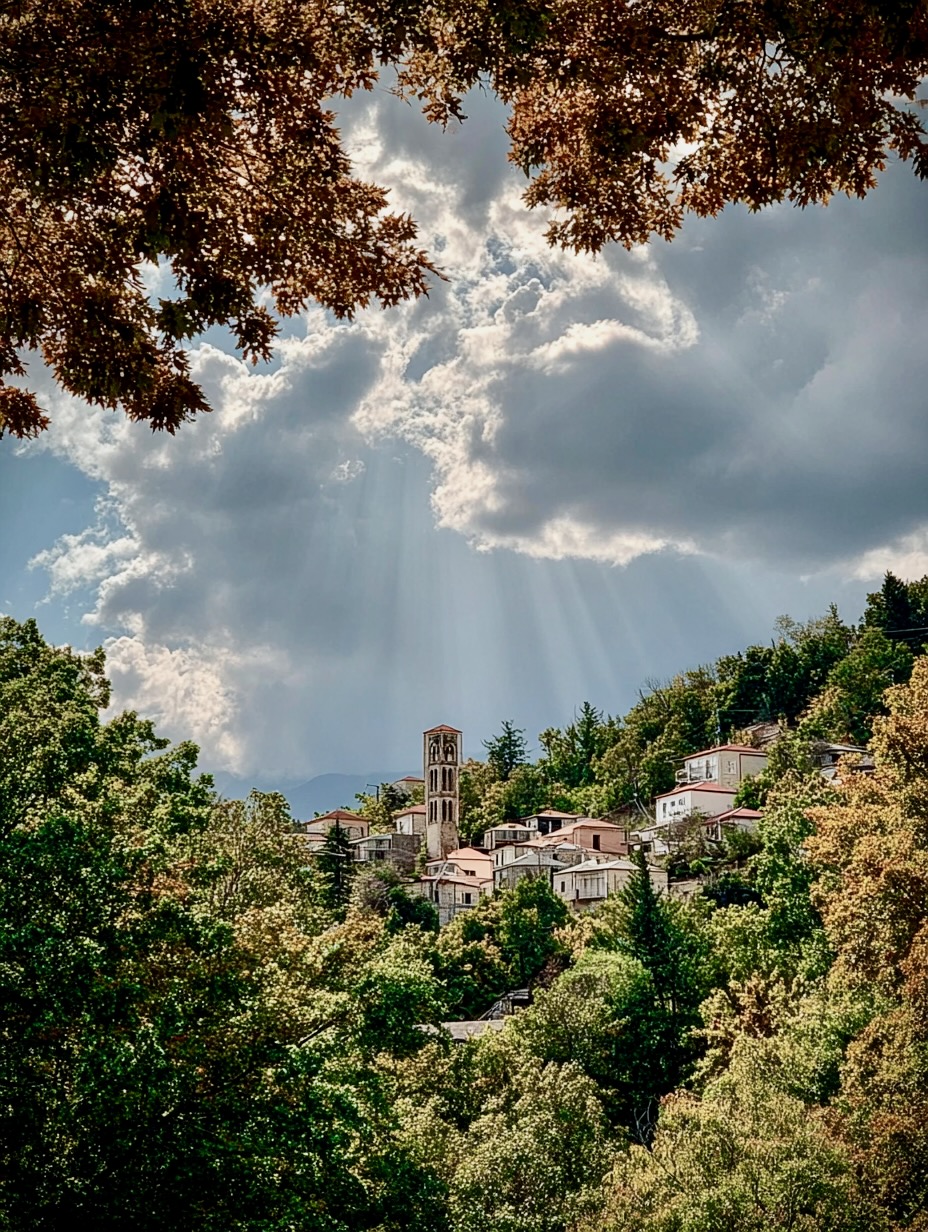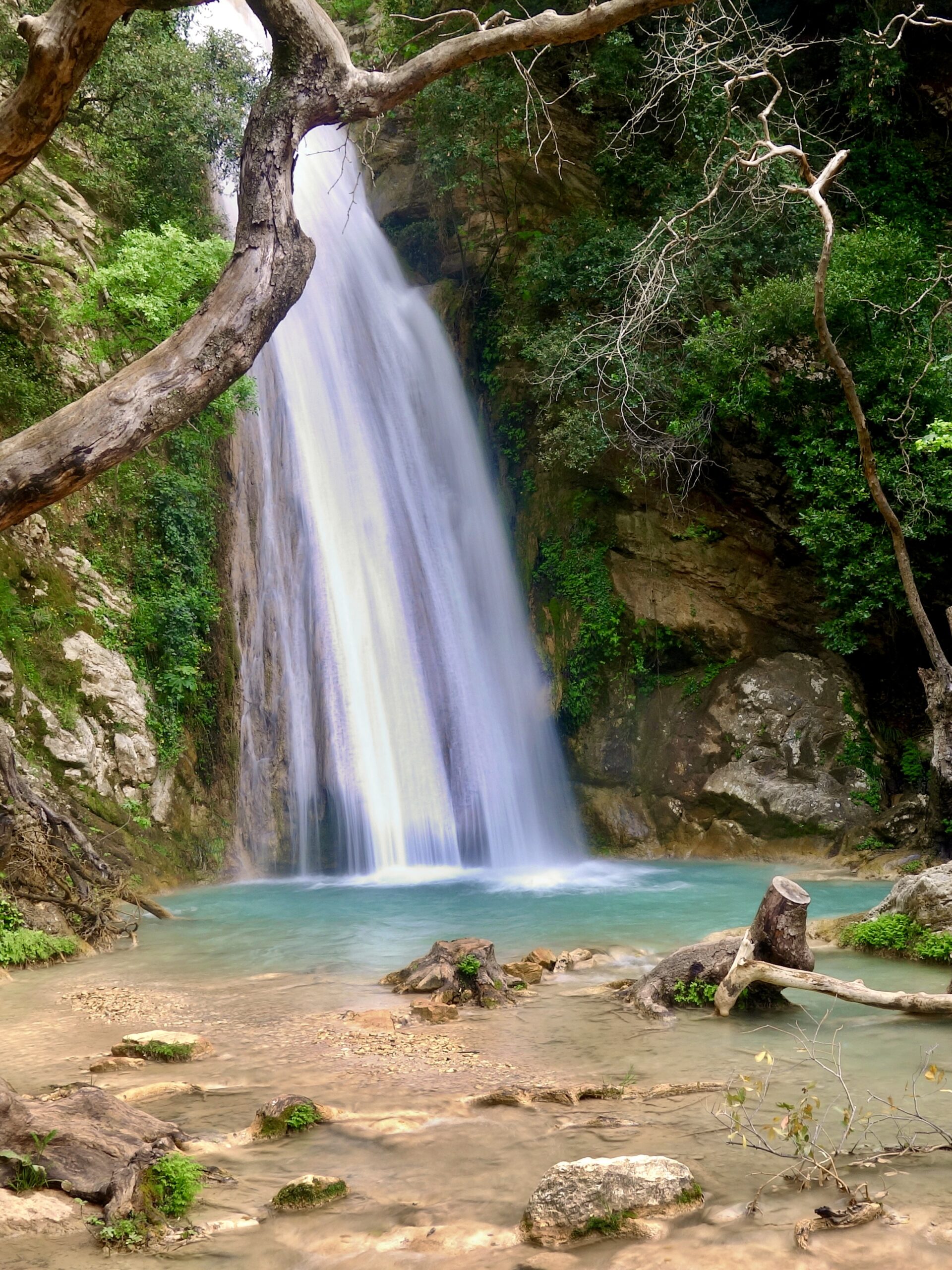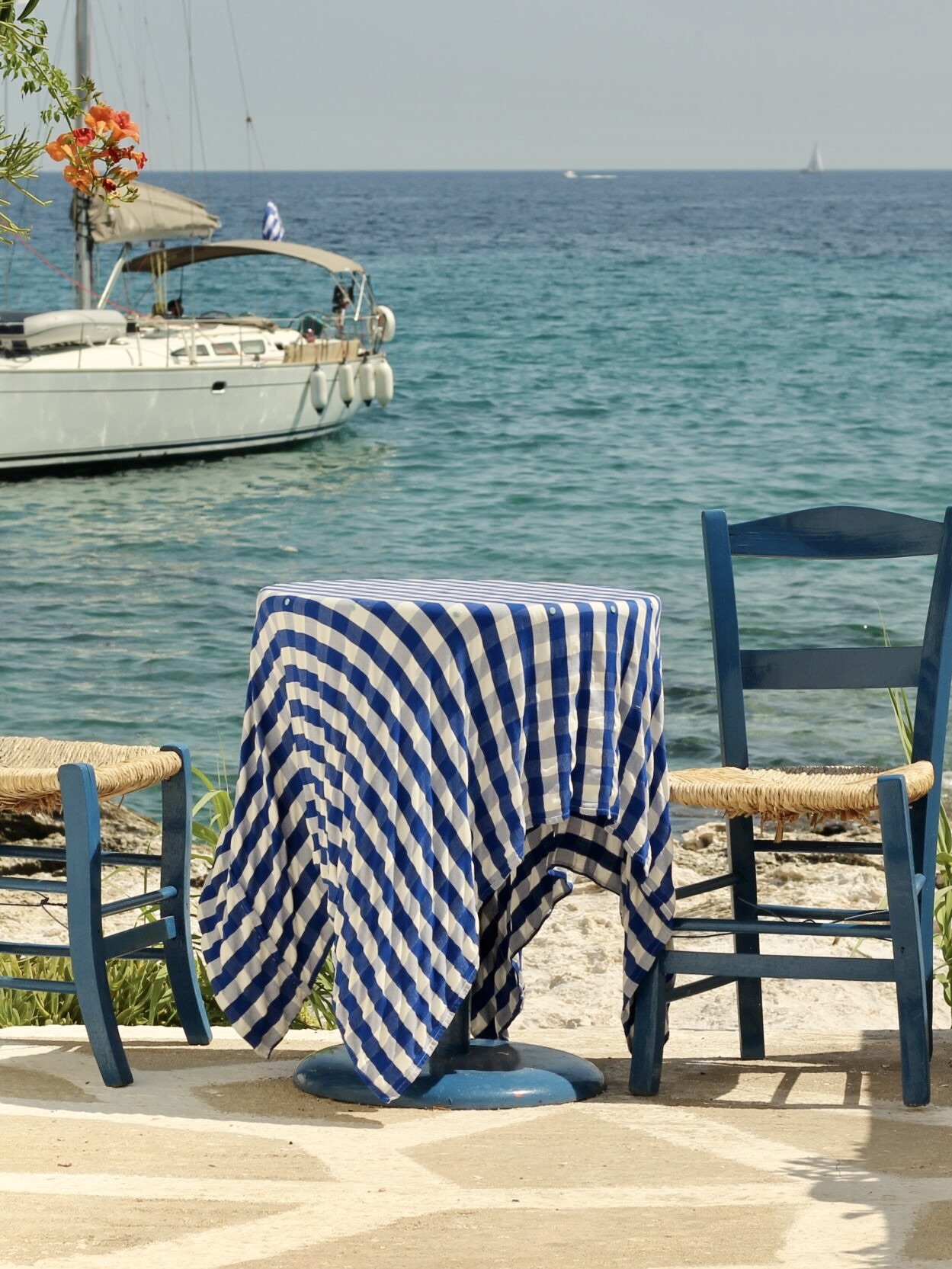A weekend on Kythnos is enough to feel the island’s Cycladic poise work on you. Just 25 nautical miles from Attica, Kythnos has beauty, traditional architecture, and marquee sights – yet it has sidestepped the machinery of mass tourism. Which, frankly, is its blessing.
It remains largely untouched. Two jewel-like settlements – Chora and Dryopida. The spare, sun-burnished Cycladic landscape. A major archaeological site at Vryokastro, once the ancient city, where ongoing excavations keep revealing buildings and rare portable finds. And a scalloped coastline of beaches, each seemingly lovelier than the last.
Kolona may be the star not just of Kythnos but of the Aegean. Tourism here never led the narrative; the famously warm locals turned to it only recently. Windmills scattered across the island recall centuries when agriculture anchored the economy. The island raises livestock known for exceptional meat, turns out standout cheeses, and produces thyme honey so prized it rarely lingers on shelves.
Meríchas and Vryokastro (Ancient Kythnos)
The ferry docks at Merichas, the island’s port – a place I’ve often seen in passing on the way to other islands but had never stepped into. This time, I do. Even with its marina for yachts and sailing boats, its many rooms to let, shops, tavernas, cafés, and bars, Merichas still breathes Aegean. The settlement sits at the head of a closed bay, caught between the sea’s blue and the island’s lean Cycladic palette – scant green, all the ochres and browns.
At one end of the narrow beach rises the church with the curious name Agioi Akindynoi (means harmless), regarded as patrons of the port and passing ships; its big panigyri (celebration) is on November 2. Another historic church, Panagia Episkopi, stands by a nearby beach, accessible by paved road. Close by is the Vryokastro archaeological site, identified as Ancient Kythnos, inhabited from the 12th century BC to the 6th–7th centuries AD.
On the acropolis, archaeologists have brought to light a sanctuary of Goddess Demeter and Kore (her daughter) from the Classical era. On a lower terrace, two monumental rectangular buildings – likely 4th or 3rd century BC temples – and another sanctuary at the plateau’s northern edge. The digs continue to yield portable treasures: figurines, vases, hydriae, ceramics, votive offerings, pyxides (compasses), jewelry, and more. In 2023, finds spanned the Archaic through Hellenistic periods: two built altars and, beside them, a twin temple, probably 7th century BC. The adyton (the place mortals can’t reach) was intact, its Archaic votives – chiefly fine jewelry – still in situ. The deities remain unconfirmed, though the evidence points to Gods Apollo and Artemis. A dry-stone-edged path climbs to the acropolis summit; on-site signage orients you.
A Walk Through a Quintessential Cycladic Chora
Chora drapes the western slope of Prophet Elias hill, hidden from the sea, inhabited since the 17th century. Also known as Mesaria, it’s disarmingly hospitable. Whitewashed houses tangled with bougainvillea and basil. Tight lanes and pass-throughs tumbling into little squares full of flowers. Churches. Whitewashed terraces everywhere. A main cobbled spine of thoughtful boutiques, café-bars, and restaurants—color-forward, beautifully lit. Local resident Mrs. Flora has painted neighborhood scenes on house walls, amping the cheer. Stroll and catch the small rhythms—older women sharing news from low walls, children playing freely—no cars here—your gaze softens, your breath evens.
Chora is home to the pottery studio of Giorgos Georgoulis, where the ceramic tradition runs through generations, from traditional to modern, functional to decorative—the color-drenched showroom is a lesson in self-restraint. The village’s oldest church is the single-aisled basilica of Agia Triada. You’ll also find Agios Savvas, built in 1613 with the coat of arms of the Venetian Gozzadini lords, and Metamorphosis (Transfiguration), whose iconostasis was painted in the 17th century by artists of the Cretan School.
The Archaeological Museum of Kythnos sits here too, in the neoclassical former primary school, with finds from Vryokastro and the Mesolithic site at Maroulas. For a short stroll beyond the village, head to the Monastery of Nikous (1 km) for a panoramic sweep. Its name comes from the Byzantine epithet of the Virgin, Nikopoios, “Bringer of Victory.” Built atop the ruins of an ancient temple, its katholikon is quintessential post-Byzantine Aegean.
Dryopida and the Katafiki cave
Dryopida’s red-tiled roofs hide in a ravine between two hills, invisible from the sea – at first glance, more Epirus than Cyclades. Once called Syllakas, it took its current name under King Otto, linking it to the pre-Hellenic Dryopes who settled here in the Archaic period. Pottery thrived in the village; tiled roofs arrived after locals worked in Athens’s kilns.
This settlement is as authentic as they come – and quieter than Chora. With a defensive layout, it’s a tangle of narrow lanes lined with bright pot plants, low lean-tos, and arches that conceal doors and windows. Wander the Cycladic labyrinth and let it unfold. The large central church is dedicated to the Apostles and Saint Anna. In the Galatas quarter, the parish church honors Saint Minas. There’s a Folklore Museum and an Ecclesiastical Museum in the church of Agios Georgios. For tavernas, small shops, and cafés, head to Piatsa.
From the main lane, follow signs to the Katafiki cave, south of the settlement at Fires. In earlier times, Easter was celebrated in its main chamber, the “Great Square.” In the interwar period, a foreign mining company owned the cave and cut an artificial tunnel connecting it with the sea. Beyond the Great Square, a winding corridor leads to the “Stalactite Chamber,” with stepped galleries and stalactite walls. During the Aegean’s pirate years, locals used the cave as a refuge.
Loutra’s thermal springs, and the Katakefalos castle
Spread across three coves on the northeast coast, Loutra is Kythnos’s busiest resort area. Cafés and restaurants sit shoulder to shoulder at the water’s edge; there’s a small marina, hotels, and rooms to let. Archaeological evidence suggests the thermal springs were used more systematically in Roman or Byzantine times. In the modern era, spa facilities were developed under King Otto. The Agioi Anargyroi spring runs at 40.5°C and is indicated for rheumatic, arthritic, and gynecological conditions. The second, Kakavos, runs hotter at 52°C—superheated, iron-rich, and open-flow; it empties straight into the sea near the cove, and people soak even on cold winter days.
North of Loutra, a dirt road becomes a 3.5 km footpath to the island’s medieval capital. When inhabitants left Vryokastro in the 6th century AD, they moved to the sheer height of Katakefalos and fortified it. Under the Venetians, a thriving castle-town rose here; tradition counts 100 churches. Today, only Agia Eleousa—also called “Keralousa”—survives, along with fragments of wall and house ruins. Local lore links Katakefalos to the legendary “Castle of the Fair Maiden” from the Acritic ballads—a name shared around Greece. What’s certain: the Ottomans destroyed it in 1570, and it was never resettled.
Panagia Kanala
The domed basilica of Panagia Kanala stands at the tip of the bay’s arm where the namesake seaside settlement lies. Built in 1869 on the site of an earlier church, it houses Kythnos’s most sacred symbol: the wonder-working icon of the Panagia Kanala. Legend says fishermen from Kythnos discovered it in the narrow channel – kanali – between Kythnos and Serifos. The island’s most important pilgrimage site, it celebrates with a grand festival. The settlement is well developed, with small hotels and rental homes or apartments.
Beaches and diving
Schist erosion has carved Kythnos’s shore into a chain of intimate coves—sand or pebbles, many unorganized, reached by paths or dirt roads. For several, the smartest approach is by rented boat.
West coast
Kolona: the island’s signature beach—and a Cycladic icon—with electric-turquoise water where yachts and sailboats anchor. A sandbar—230 meters long and 30–80 meters wide—ties the peninsula, crowned by the white chapel of Agios Loukas, to the island and sketches two bays. The western side runs warmer than the eastern; either way, the swim is unforgettable. Access is via a narrow, potholed dirt road.
Fikiada: close to Kolona, with golden sand.
Apokrisi: a long sandy arc with tamarisks and deep blue-green water; among the busiest, thanks to easy access by paved road.
Episkopi: the beach near the historic church, with a few tamarisks; also reached by paved road. Shallow waters make it a family favorite.
Flampouria: south of Merichas, a wide sandy strand below the church of Panagia Flambouriani.
East coast
Gaidouromantra: at the southern end; pebbles at the edge, sandy bottom within. Access via dirt road and steps.
Agios Sostis: at the island’s northern tip, with sand and fine pebbles below the tiny chapel of the same name.
Agios Stefanos: sand, pebbles, and tamarisks.
Lefkes: sand and pebbles, with Piperi islet on the horizon, below the summer settlement of the same name.
Megali Ammos: true to its name, a generous sweep at the head of the bay in Kanala.
Potamia: north of Loutra, a secluded sandy cove with deep water and a few tamarisks.
Diving
Kythnos’s seafloor is a quiet revelation – teeming, textured, and suited to every level. Highlights include two walls, the so-called Abyss, the Crater, Vouvokera, the Glyfada reef, the “Submarine,” and more, plus the wrecks of the Pepe Michalis and the Papoutsadiko.



